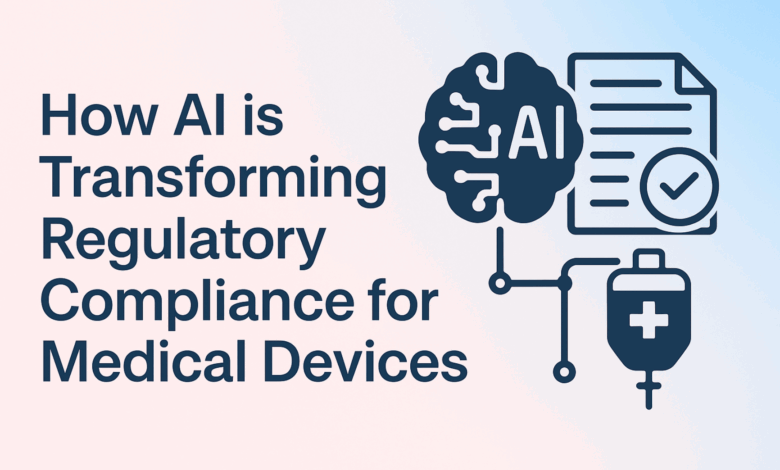
Introduction: Why the Industry is at a Tipping Point
If you have ever been in a regulatory affairs office at 10 p.m., you probably remember the smell of stale coffee and the hum of a printer that will not stop.
Stacks of binders propped against one another, fifteen browser tabs competing for your attention, and a 510(k) draft on screen that feels heavier than its actual weight.
In medtech, compliance is more than paperwork. It is the single wall between a breakthrough device and the patient who needs it. Every month of delay is money lost, momentum lost, and in some cases, a patient outcome that could have been better.
The FDA process is intentionally thorough, which is another way of saying slow. Guidance is scattered across thousands of documents, often updated quietly. Finding the right precedent can feel like chasing smoke through a maze.
AI is starting to change that. Not in the flashy, diagnostic-image-recognition sense, but in the unglamorous trenches of regulatory compliance. That shift might end up changing not just timelines but the economics and the working culture of medtech.
From Binders to Algorithms: The Historical Shift
Twenty years ago, everything was on paper. Submissions were physically delivered, and if you wanted a predicate device, you pulled summaries out of a filing cabinet.
The mid-2000s brought digitization. PDFs replaced binders, online databases became common, and email took over from couriers. Over the last decade, cloud-based QMS tools became the default, but most of them simply digitized the old habits instead of reinventing them.
AI is different. It does not just store documents, it can read them, connect them, and extract meaning. In regulatory work, that is like moving from a typewriter to a word processor. It is a fundamental change in what is possible.
Why Now? Pressure Meets Possibility
AI in compliance has been discussed before, but the tools were not ready. Now they are. Why?
- Regulatory signals. The FDA’s Elsa AI project is a sign the agency is open to AI-assisted processes.
- NLP breakthroughs. Language models can now parse messy, unstructured regulatory text with surprising accuracy.
- Cost pressure. Margins are tight and every month saved before launch can mean millions in revenue.
- Talent shortage. Experienced regulatory staff are scarce, especially in niche device areas.
For early adopters, this is a rare window. The technology is mature enough, the need is urgent, and the regulators are beginning to discuss it openly.
The Regulatory Bottleneck Everyone Knows
If you’ve ever prepared a 510(k) for a Class II device, you know it’s not a quick job. Proving “substantial equivalence” to an existing device sounds simple until you open the first file. Then it’s hours of digging through decades-old approvals, testing reports in every format imaginable, and risk assessments that read like they were written for another era.
A single submission can send you chasing:
- FDA guidance documents that stretch into the hundreds of pages.
- Predicate device summaries, each with its own quirks in style and depth.
- Technical standards such as ISO 10993 or IEC 60601, both of which have gone through multiple revisions.
- Recall notices and adverse event records you’ll need in case reviewers start asking pointed questions.
For many regulatory teams, especially in smaller companies, the search and sorting work eats up as much as 40 percent of the total submission time. That’s more billable hours for consultants, more internal delays, and too often, a launch that slips into the next quarter. And the cost isn’t just in money. Every extra month is a chance for a competitor to pull ahead, an investor milestone to be missed, or a patient to wait longer for a device that could help them now.
The AI-Regulatory Maturity Curve
From what we have seen in the field, adoption tends to move through three stages:
- Search and Retrieval. Teams use AI to locate FDA guidance, predicate device summaries, and standards in seconds rather than hours. It is the entry point for most organizations because the payoff is immediate: less time scrolling, fewer missed references, and a shared source of truth for the entire team.
- Pattern Recognition and Prediction. Here, historical clearance data becomes more than an archive. AI tools surface trends, such as which device categories are clearing faster, or which types of claims tend to trigger additional information requests. This stage helps teams plan their submissions with fewer surprises.
- Intelligent Automation. The most advanced tier. Drafting sections of a 510(k) from structured evidence, monitoring regulatory changes in real time, and updating compliance files automatically. It is rare to see this stage fully implemented, partly due to trust and validation requirements, but it offers the greatest long-term efficiency gains.
Right now, most teams remain in Stage 1. The forward-leaning ones are experimenting with Stage 2. Almost no one is operating fully in Stage 3 yet, which means there is still space for early adopters to lead.
AI in Action: Four Practical Examples
- Smarter Document Search
Instead of scrolling through hundreds of pages to find a testing requirement, an NLP system can pull the exact section in seconds.
The payoff is not just speed, it is accuracy. Everyone works from the same, most current material. - Insights From Unstructured Data
The FDA outputs mountains of data every year. Machine learning can spot patterns, such as which devices are cleared faster, what triggers Additional Information requests, and how testing norms are shifting.
A small startup once saw that devices in their category often hit delays over software validation. They built the evidence into their initial submission and shaved months off review. - Risk Forecasting
Models can warn you early. If devices like yours hit biocompatibility questions most of the time, you can run the tests up front instead of waiting for the reviewer to ask. That can save months of waiting. - Drafting Assistance
Generative AI can produce a first draft of certain sections. It is not perfect, but it removes the blank-page problem and frees human experts to focus on strategy.
The ROI in Real Terms
If a 510(k) takes 1,000 hours of professional time, even a 30 percent cut means 300 hours saved. That is $30,000 to $50,000 in reduced consultant or staff cost.
For a device expected to bring in $500,000 a month, saving three months is $1.5 million in extra revenue. This is before counting market share advantages.
The Barriers Still Standing
- Data Security. Any AI touching regulatory work needs airtight protections for designs, testing data, and sometimes PHI.
- Trust and Transparency. Black box answers do not survive audits. Explainability matters.
- Human Judgment. A model can draft, but it cannot decide. A missed nuance can derail a submission.
- Regulatory Buy-In. The FDA is interested, but acceptance will come only with proof of quality gains.
The Skills Shift Ahead
Tomorrow’s regulatory professionals will need:
- Data literacy to check AI outputs.
- Comfort with AI workflows.
- Stronger collaboration with IT and data teams.
These will sit alongside traditional skills like submission drafting and regulatory strategy.
A Collaborative Future
The real leap will happen when regulators and industry work together. Imagine shared anonymized submission datasets for model training, clear guidance from the FDA on approved AI use, and public-private efforts to make AI-powered compliance tools accessible to smaller companies.
This is not far off. Pharma has already done similar things for drug safety monitoring.
The Ripple Effect
Better compliance tools help more than just manufacturers. Testing labs get better-prepared samples. Investors see risk earlier. Patients get devices sooner.
When compliance becomes more efficient, the benefits spread across the medtech ecosystem.
What to Do Now
A smart first step is to test AI in a single, low-risk part of the workflow, such as predicate device research. Once you see how it performs, it becomes easier to expand into other areas. Keep people in the loop at all times, using the technology to assist rather than replace expert judgment. Keep a clear record for future reference by writing down what was done and how it was done. Above all, make sure the regulatory data feeding the system is accurate and current. Clean inputs lead to reliable outputs.
Closing Thoughts
In regulatory affairs, speed without accuracy is dangerous, but accuracy without speed can hold a product back until the opportunity has passed. AI offers a way to achieve both. It does not take the place of experts. Instead, it takes the weight of repetitive searches, cross-checking, and document formatting off their shoulders so they can focus on the decisions that truly influence the success of a submission.
The last decade was about moving from paper binders to digital files, from static archives to searchable databases. The decade ahead will be about making those systems smart enough to interpret, connect, and predict. In medical technology, that shift could be the deciding factor between a device reaching patients within months or being delayed for years. For the people waiting on new treatments, that is not an abstract benefit. It is the difference between receiving care in time or not at all.




